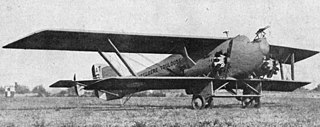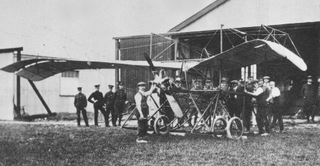The Wright Flyer III was the third powered aircraft by the Wright Brothers, built during the winter of 1904–05. Orville Wright made the first flight with it on June 23, 1905. The Flyer III had an airframe of spruce construction with a wing camber of 1-in-20 as used in 1903, rather than the less effective 1-in-25 used in 1904. The new machine was equipped with the engine and other hardware from the scrapped Flyer II and, after major modifications, achieved much greater performance than Flyers I and II.

The Wright Flyer II was the second powered aircraft built by Wilbur and Orville Wright. During 1904 they used it to make a total of 105 flights, ultimately achieving flights lasting five minutes and also making full circles, which was accomplished by Wilbur for the first time on September 20.

The Maurice Farman MF.7 Longhorn is a French biplane developed before World War I which was used for reconnaissance by both the French and British air services in the early stages of the war before being relegated to service as a trainer.

The Farman III, also known as the Henry Farman 1909 biplane, was an early French aircraft designed and built by Henry Farman in 1909. Its design was widely imitated, so much so that aircraft of similar layout were generally referred to as being of the "Farman" type.

The Bréguet Type I was an experimental aircraft built in France in 1909. It was Louis Bréguet's first fixed-wing aircraft design. Bréguet had previously had some success with two helicopter designs, one of which had been exhibited at the Paris Aero Salon in December 1908. Because of these machines, the Type I was at first known as the Bréguet Type III.

The Latécoère 6 was a French four-engined biplane bomber of the early 1920s. It was of advanced all-metal construction and probably the first aircraft to use geodetic construction. Only one was built.
The Short No.2 was an early British aircraft built by Short Brothers for J.T.C. Moore-Brabazon. It was used by him to win the £1,000 prize offered by the Daily Mail newspaper for the first closed-circuit flight of over a mile (1.6 km) to be made in a British aircraft.

The Short S.41 was a British single-engined biplane built for the Royal Navy in 1912. Capable of being operated either on wheels or floats, it was successful enough for a further two similar aircraft to be built, with the type remaining in use until the early years of the First World War.
The Epps 1909 Monoplane was a fixed-wing aircraft that was designed and built in 1909 in Athens, Georgia by Ben T. Epps and his business partner Zumpt Huff.

The Dunne D.7 was one of J. W. Dunne's swept wing tailless aircraft designed to have automatic stability, first flying in 1911. It was a single seat, single engined pusher monoplane developed from the unsuccessful D.6.

The Short S.27 and its derivative, the Short Improved S.27, were a series of early British aircraft built by Short Brothers. They were used by the Admiralty and Naval Wing of the Royal Flying Corps for training the Royal Navy's first pilots as well as for early naval aviation experiments. An Improved S.27 was used by C.R. Samson to make the first successful take-off from a moving ship on 9 May 1912.

The Howard Wright 1909 Biplane was an early British experimental aircraft designed and built by Howard T Wright. It was displayed at the first Aero Show at Olympia in March 1909, and although only one was built, it was the first of a series of aircraft built by Wright that were to earn him brief fame as one of England's foremost aircraft manufacturers in the early years of flight.
The Howard Wright 1909 Monoplane was the first of a series of tractor configuration monoplane aircraft built by Wright in England during 1909 and 1910. A variant, the Lascelles Ornis, was displayed at the 1910 Aero Show at Olympia in London.
The Short S.80 was an early British floatplane built by Short Brothers for Frank McClean to undertake an aerial expedition up the Nile to investigate the cataracts between Aswan and Khartoum. After a successful flight to Khartoum it was returned to England, where it was used for training by the RNAS. When built it was the largest successful aircraft that had been constructed in Britain. It was also known as the Short Nile Pusher Biplane Seaplane.

The Short S.36 was a British two-seat tractor biplane, built by Short Brothers for Francis McClean in 1911. It was later developed into the Short S.41 and Short S.45, which were the first of a long series of similar aircraft built for the RNAS and RFC.
The Short S.47 Triple Tractor was one of a series of experimental twin-engined aircraft built by Short Brothers in 1912. It acquired its name because the two engines drove three tractor propellers.

The Bland Mayfly was an early aircraft constructed in 1910 by Lilian E. Bland in Carnmoney in Ireland. It is credited as the first aeroplane to be designed and constructed by a woman.

The Sommer 1910 Biplane was an early French aircraft designed by Roger Sommer. It was a pusher configuration biplane resembling the successful Farman III, and was built in large numbers for the time. One was owned by Charles Rolls.

The Caudron Type A was the first successful aircraft built by René Caudron and his brother Gaston. During 1910 the Caudron brothers were briefly associated with the Société Anonyme Français d'Avaiation (S.A.F.A.), and an example of the type was exhibited at the 1910 Paris Aero Salon as the S.A.F.A. Biplane.

The pioneer era of aviation refers to the period of aviation history between the first successful powered flight, generally accepted to have been made by the Wright Brothers on 17 December 1903, and the outbreak of the First World War in August 1914.














